Things are moving forward
There is no doubt that the "Erste Lage" concept has developed into a success story in recent years after bumpy beginnings. Especially the dry Grosse Gewächse and Erste Gewächse (the latter only in the Rheingau) are the focus of attention every September among local and increasingly also foreign experts. The quantity of wines produced has also risen steadily in recent years: While in 2002 only 108 dry top wines came onto the market, this year there are already 360 (expressly not counting the part of the Rheingau First Growths that are produced with sugar values in the legally semi-dry range due to a special regulation).
It is particularly pleasing that the qualitative development has not come to a standstill during this time. In the past, the VDP had to put up with considerable criticism because too many of the wines presented did not meet the high standards by far. Today, the Grosses and Erstes Gewächse are by no means always truly "great", but they are almost all of a high standard with a much more homogeneous quality.
The 2008 vintage
The increased quality consciousness is particularly evident in a relatively difficult vintage like 2008, whose weather conditions did not necessarily give cause for euphoria at first. For the first time in a long time, producers had to worry about the ripeness of their grapes, even in top vineyards. Those who did not delay the harvesting time as long as possible and who did not pre-harvest and select thoroughly could not expect a first-class result in most cases.
Nevertheless, many producers succeeded in making great wines. The conditions of the vintage had some very pleasant side effects: the relatively low must weights led to largely moderate alcohol levels even in the top growths. At the same time, the best wines have a lot of extract and an unusually present, often somewhat earthy minerality due to the good water supply and the long vegetation period. I hardly know a vintage in which the different site characteristics were expressed as clearly as they were in 2008.
In addition, this year some producers who have tended to work below their capabilities in the past years are coming back with impressive collections at the top. Obviously, the difficulties in autumn were a challenge for many wineries to significantly increase their efforts in the vineyard and cellar. Thus, with the 2008 vintage, we are experiencing predominantly positive surprises. Even the few really weak wines, which unfortunately still exist, cannot dampen our joy. But if the development continues like this, perhaps these outliers will soon be a thing of the past.
Although only a dozen or so Grosser Gewächse are produced from a single grape variety in the Mosel, the stylistic differences could hardly be greater. They range from slender, almost filigree and yet radiantly clear Rieslings, such as those produced by Ernst Loosen, to the powerful, almost fat, extraordinarily spicy and earthy-mineral examples of a Clemens Busch. In between, there are gradations - one for almost every producer. At the top is probably still Reinhard Löwenstein (Weingut Heymann-Löwenstein), who has only been able to present a part of his wines so far, but Theo Haart (Weingut Reinhold Haart) also convinced us with his intensely mineral Ohligsberg.
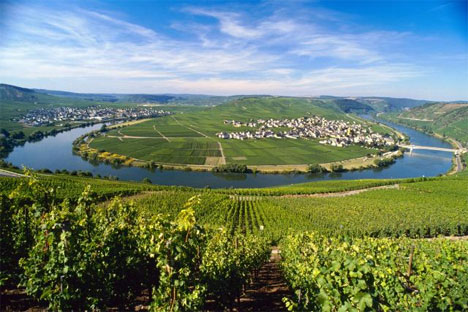 |
| Moselschleife between Leiwen and Trittenheim (DWI/Hartmann) |
In contrast to the dry Rieslings, which nowadays receive much more attention than in the past, hardly anything has changed with the sweet varieties since the term "Erste Lage" was introduced, apart from the additional designation. The 2008 vintage also seems to us to have been less favourable for this type of wine than 2007 - despite some convincing results. Although the sometimes racy acidity will appeal to many Mosel friends, most of the wines ultimately lack the depth and complexity of their predecessors; in addition, rough tannins often cause a bit of trouble, especially for the Prädikat Kabinett to Auslese. The number of noble sweet tops is also significantly smaller than usual, but there are definitely some brilliant successes.
Middle Rhine
Just 5 Grosse Gewächse were produced in the Middle Rhine this year. This is certainly mainly due to the small number of VDP wineries located here. The sites, some of which are magnificent, should actually produce many more. Unfortunately, we were only introduced to the representatives from Bacharach and Steeg, of which we liked the two expressive and viable Rieslings from the Ratzenberger estate.
This year, the wines from Künstler and Weil mark the top of the First Growths in the Rheingau. Firmness, depth, power and a lot of minerality are common to all three wines from the two wineries, except that Künstler's Rieslings seem even more closed, compact and inaccessible than the Gräfenberg, which is also still underdeveloped but already noticeably finer. We are used to the excellent results of Johannishof, Schloss Johannisberg and Langwerth von Simmern in this class, but F.B. Schönleber has also found its old strength. We are really surprised by Weingut Barth, which presented the best dry Riesling we have ever tasted from this house, but also by Prinz von Hessen and Joachim Flick, who are each represented with at least one wine in the top group. In general, the qualities across the board seem to us to be much more reliable than in 2007.
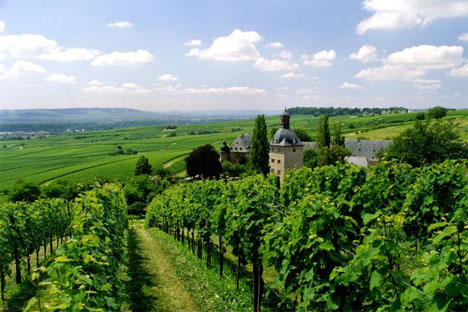 |
| View of Vollrads Castle (DWI/Hartmann) |
Nahe
There are also surprises on the Nahe. Although Emrich-Schönleber and Dönnhoff are again at the top this year, the Diel vineyard is now easily keeping up. In character, however, the Rieslings of these three wineries differ considerably. Dönnhoff's Hermannshöhle is currently rather forbidding, cool and tart, it seems leaner than it is, but nevertheless already claims a top position due to its depth, firmness and astonishing noblesse. The situation is not much different for the somewhat earthier Dellchen. The two Rieslings from Emrich-Schönleber are considerably stronger, yet at the same time juicy and racy, the Halenberg, however, also very closed, the Frühlingsplätzchen, as always, a little more accessible and playful. At Weingut Diel, the wines seem to be getting finer and finer under the direction of Armin Diel's daughter Carolin. Their Grosse Gewächse are probably often underestimated at first sip, only on closer inspection do they reveal their full aromatic potential and their tremendous subtlety with excellent structure and depth. It was good for the wines that the usual rounding off with residual sugar was completely dispensed with in 2008: for this very reason, they are particularly fine, exceptionally harmonious and perfectly focused. Clearly more accessible, but of surprising quality, are the two wines from the Schloßböckelheim estate. They already taste lively and animating, but also have firm structure and substance for further positive development. The Rieslings from Schäfer-Fröhlich are still rather restless, their spontaneous fermentation aromas sometimes still verging hard on the "Böckser" - an impression that itrritatingly tends to intensify rather than weaken with air at the moment. But it is precisely this, in combination with the quite tangy carbonic acid and the noticeable residual sweetness, that should evoke enthusiasm, especially among Mosel friends, even if the wines, for all their animating nature, seem to lack the depth of the best representatives of the vintage. Our ratings are therefore rather cautious; it remains to be seen how well the wines can actually develop.
Rheinhessen
Although most of the wines from two of the most important producers in the area - Wittmann and Keller - are still missing, the performance show in Rheinhessen is already quite impressive. First of all, this is due to the two wineries Battenfeld-Spanier and Kühling-Gillot, which are under one management, but whose wines could not be more different. They all have power, but while Battenfeld-Spanier's Rieslings from the Wonnegau are clearly livelier and more fruit-driven, those from Kühling-Gillot clearly express the site characters of the Rote Hang on the Rhine front in their much warmer and melting style and with their earthy, sometimes oily aromas. The same is true of the surprisingly strong wines from Sankt Antony, while the Gunderloch vineyard largely shares the aromatics of the other Rieslings from the Roter Hang in its growths, but otherwise focuses more on leaner construction and finesse, which makes them seem considerably cooler. The Wagner Stempel vineyard, for all the quality on offer, is perhaps not quite up to its best performances of previous years. In the case of the Heerkretz, however, this may be due to the clear residual sweetness, which takes away a little of the wine's compelling quality. Here, an improvement would be quite conceivable if the wine harmonises with bottle maturity. The same is true for the Liebfrauenstift church piece from Gutzler, but its noticeable tannin is still a bit in the way at the moment. The much more convincing results of the Staatliche Weinbaudomäne Oppenheim and Schloss Westerhaus compared to the past are pleasing.
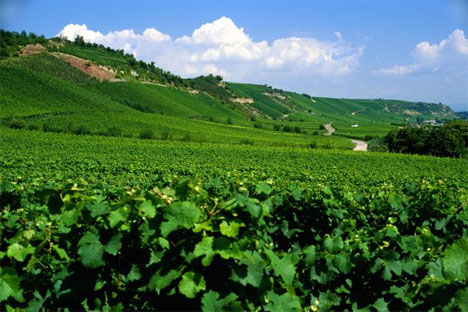 |
| The "Rote Hang" (DWI/Hartmann) |
Palatinate
The Palatinate is certainly one of the big winners of the vintage. The best wines - and there are a lot of them - combine expressiveness and depth with elegance. The alcohol levels are lower than they have been for a long time. The biggest surprise this year is the excellent performance of the Reichsrat von Buhl winery. We have never tasted such characterful, fine and profound wines from this famous estate. Moreover, they are so typical of their origins that it is not difficult to guess most of the vineyards even in a blind tasting. It is not much different with the Grosses Gewächse of some other estates in the Pfalz, such as the magnificent examples from Rebholz, Wehrheim and Meßmer in the southern part or those from Müller-Catoir, Bürklin-Wolf, Bassermann-Jordan and Knipser in the Mittelhaardt - even though they are undoubtedly stylistically quite different. Steffen Christmann's Rieslings still seem somewhat unfinished for the most part, but nevertheless reveal complexity and depth. The Idig, which impresses year after year, is facing serious competition from the Langenmorgen this year. Philipp Kuhn's Rieslings are clearly influenced by the house style and seem much stronger, smoother and warmer than most of the other Palatinate Grosses Gewächse, without lacking the distinct soil character that can be found almost everywhere in the Palatinate this year in the top Rieslings. The Pinot Blancs are usually a little behind the Rieslings this year, but Rebholz, Wehrheim and Münzberg have also produced first-class wines in this area, closely followed by Bergdolt, Pfeffingen, Bernhart and Meßmer. In addition to the absolute top Rieslings, there are many other excellent wines that are worth tasting and whose development one should keep an eye on. Especially from wineries like Mosbacher, one is used to the fact that their Rieslings can still improve with a little maturity. Occasionally, the Palatinate also produces sweet and noble-sweet Erste Lagen. Müller-Catoir, von Buhl and Mosbacher also produce first-class wines in this area.
Baden
As in the Palatinate, many wines in Baden benefit from a clear soil character and minerality that the vintage brought with it - and the livelier acidity suits the top wines perfectly. The Burgundy varieties in particular were by no means leaner than usual, but even Salwey's extraordinary, sometimes quite powerful examples do not seem too heavy. Joachim Heger's Pinot Blanc and Pinot Gris also have plenty of power, but thanks to their minerality, their often surprisingly cool character and a very fine aroma, they seem much leaner than they actually are. In all cases, it is best to leave the wines of both producers in the cellar for a few more years, and it can be assumed that one or the other will increase noticeably as it matures in the bottle. The Burgundies of the Bercher family are still restrained in their usual way. They seem more tart and acidic than usual, without abandoning the calm, enigmatic style that has been cultivated here for years. They should also develop excellently. In Baden, too, the second row behind the absolute tops is well occupied: Burg Ravensburg, the city of Lahr and Schlumberger have all bottled remarkable wines. Among the Rieslings, the Ortenau winery Schloss Neuweier made an unexpectedly strong showing. This year, the Grosse Gewächse wines clearly stand out from the other Rieslings of the estate. In the Kaiserstuhl, Salwey, Heger and Stigler come up with excellent Rieslings that are a joy to drink.
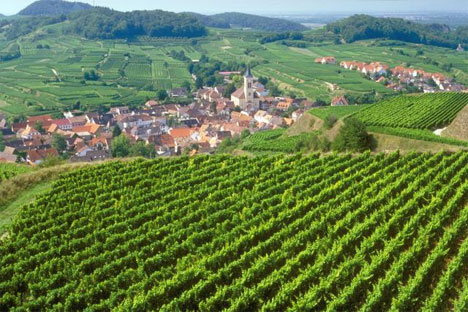 |
| Oberrotweil (DWI/Hartmann) |
For some years now, wines full of character have been increasingly produced in Württemberg. Most of the top estates are equipped with the most modern cellar technology, which in the past was sometimes perhaps given to the wines a little too carelessly. In the meantime, many producers seem to be more and more focused on producing wines that are typical of their origins and expressive. The Rieslings from Graf Adelmann and Jürgen Ellwanger are impressive examples of this development. We were even more surprised by the performance of the Weinsberg Staatsweingut, whose "Burg Wildeck" shows undreamt-of class this year. The Riesling from Fürst Hohenlohe-Öhringen seems very traditional, while the three Grosse Gewächse from Reiner Schnaitmann represent the opposite philosophy with their extremely polished style. They are tremendously animating and juicy, but could perhaps be even more impressive with a little less residual sugar. However, we are curious to see how they develop in the bottle.
Franconia
Surprisingly often it happens that Franconia delivers the strongest results in supposedly more difficult years. This was the case as recently as 2006, and in 2008, too, the best Franconian wines are among the top of all Grosses Gewächse. The performance of the Juliusspital, which not only reached the exceptional level of the previous year, but also clearly surpassed it across the board, leaves one completely speechless. Both with its
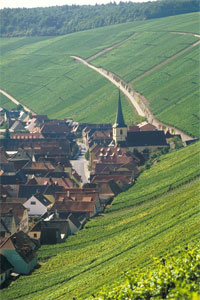 |
| Escherndorf (DWI/Dieth) |
Riesling from the Randersackerer Pfülben as well as with its Silvaner from the Würzburger Stein, the estate leads the best lists in Germany this year - and their counterparts from the other sites are hardly inferior to these masterpieces. Even the Pinot Blanc shows an unprecedented class. As with so many top estates, the wines from Juliusspital this year captivate with a rarely experienced site typicality as well as astonishing finesse despite enormous power. The situation is similar with the magnificent Grosses Gewächsen from Störrlein, Schmitts Kinder and Horst Sauer. The Ruck estate continues to cultivate its idiosyncratic, very traditional and uncompromising style at an excellent level. Paul Fürst's performance was also very pleasing, as he returned to the top group of Riesling producers in Franconia with a very fine Grosses Gewächs. But the list of top-class wines is considerably longer: the Fürstlich Castell'sche Domänenamt, Wirsching, Bürgerspital and Fürst Löwenstein come up with wines capable of development and cement the impression of a region whose reputation is currently clearly lagging behind the achievements shown.
Saxony and Saale-Unstrut
In years with delayed ripening, the areas in the east of the country that lie relatively far to the north and are characterised by a more continental climate naturally have a particularly hard time. This is particularly noticeable with Riesling, while the presented Pinot Blancs from the Pawis, Lützkendorf and Schloss Proschwitz wineries were quite convincing. We are confident that the latter in particular will continue to develop positively.
The red wines
While the new white wines are limited to the 2008 vintage, the red wines are mainly from the 2007 vintage, but also 2006 and a 2004 vintage are currently on the market. While 2007 is clearly a top vintage, 2006 and especially 2004 produced rather mediocre qualities. The results of the 2004 Pinot Noir "R" from Rebholz and the first-class 2006s from the Knipser family, who were successful with three Pinot Noirs, are all the more astonishing.
The 2005 vintage already had the reputation of documenting a qualitative revolution in red wine in Germany, but in our opinion many highly traded wines were still noticeably lacking in finesse and real depth - but all the less in alcohol and oak flavour. Has so much changed in the minds of the producers since then, or is it due to the special character of the vintage that we find a completely different picture in the 2007 red wines? In most cases, the wood seems to have been used much more carefully than we are used to; in return, the gain in finesse, depth, but also real substance cannot be overlooked in many places.
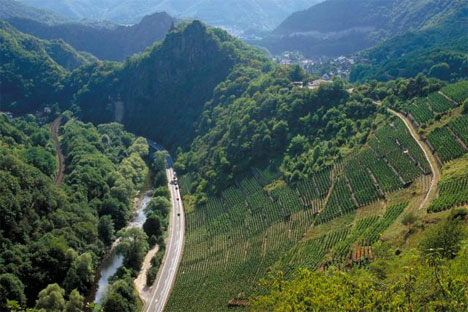 |
| The Altenahr Corner (DWI/Dieth) |
Bernhard Huber from Malterdingen in Breisgau (Baden) and Paul Fürst from Bürgstadt in Franconia are the two outstanding representatives of a style that clearly follows the finest Burgundian models without denying their own origins in the slightest. Their 2007 top Burgundies are milestones in Germany's development into a serious red wine producer at the top international level. And this is precisely because both producers do not chase after globally accepted taste models, but work meticulously on refining their own style and year after year express the character and quality of their vineyards more clearly in their wines.
But the list of producers of outstanding 2007 Pinot Noirs is long: Adeneuer, Stodden and Kreuzberg from the Ahr, Salwey and Dr. Heger from Baden, the Staatsweingut Weinsberg and Aldinger from Württemberg and, completely surprisingly, the Georg Müller Foundation from the Rheingau. In addition, there are a large number of other producers with excellent results. However, we have only tasted a part of the nominal top wines so far, so we can still expect a lot from this vintage.
With Lemberger, which can only be labelled as Großes Gewächs in Württemberg, we are experiencing something like a qualitative breakthrough: Graf Adelmann is already hinting at where the journey could lead in the future. We don't know anything better from the variety in Germany (but, by the way, hardly anything with a more awkward name: "Kleinbottwarer Oberer Berg Lemberger trocken Fünfstern Brüssele Der Schwarze Löwe Großes Gewächs", after reading the label one is exhausted for the time being). Gerhard Aldinger, Graf Neipperg and Bentzel-Sturmfeder are also convincing - and it can be assumed that there are still some first-class Lembergers slumbering in the cellars.
Click here for the results:
Baden, Riesling
Baden, Pinot Gris
Baden, Pinot Blanc
Baden, Pinot Noir
Franconia, Riesling
Franconia, Silvaner
Franconia, Pinot Noir
Hessian Bergstrasse, Pinot Gris
Palatinate, Riesling
Palatinate, Pinot Blanc
Palatinate, Pinot Noir
Rheingau, Riesling
Rheingau, Pinot Noir
Rhinehessen, Riesling
Rheinhessen, Pinot Noir
Saale-Unstrut, Riesling and Pinot Blanc
Württemberg, Riesling
Württemberg, Pinot Noir
Wuerttemberg, Lemberger
All Rieslings
All Pinot Blanc
All Pinot Gris
All Pinot Noirs
Without exception, the wines were tasted at least twice in our tasting room in Erlangen.